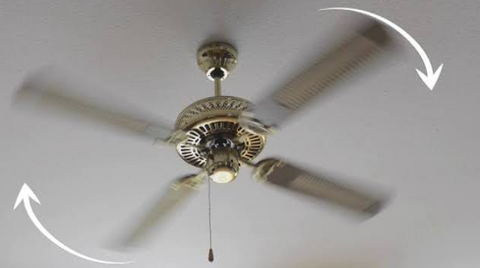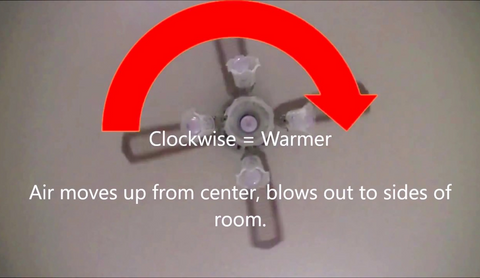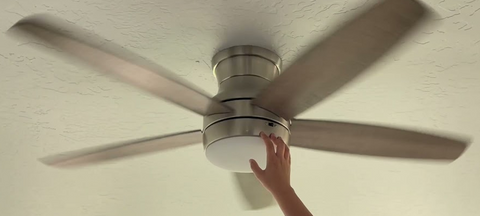Ceiling fan direction for summer and winter explained, with tips on how to ensure you're getting the most from the fan.
What Ceiling Fan Direction in Summer and Winter?

Ceiling fan direction
Resource: https://youtu.be/s3Rlug0wJe0
Ceiling mounted fans can spin both clockwise and counterclockwise. Depending on the season, you can change your ceiling fan direction to make your place feel cooler in summer — and warmer in winter. In this post, we show you how that works for a ceiling fan, which direction to use in the summer and winter seasons, and more.
Ceiling Fan Direction
Ceiling fan direction means the direction that your fan blades (or motor) spin. In the clockwise direction, the blades move from left to right. In the counter-clockwise direction, the blades move from right to left. Modern fans allow users to change the direction of the blades, as needed, using a remote module, physical switch, or phone app.
Does Ceiling Fan Direction Really Matter?
It does! Ceiling blades are built to move air in a certain direction. The angle of the blades, also called pitch, is designed to move air either up or down. This, when combined with the speed of rotation, creates the required airflow or breeze. The direction of the airflow, whether up or downward, will then depend on the direction of ceiling fan.
Direction of Ceiling Fan Rotation
A counter-clockwise ceiling fan direction will move air downwards to create a cooling breeze. A clockwise direction, on the other hand, moves the air upwards and pushes warm air downwards. But how do you know the direction that your fan blades are spinning?

Ceiling fan winter direction
Resource: https://www.youtube.com/watch?v=FgtZflskRkE
How to Tell Ceiling Fan Direction
Knowing the direction of your ceiling fan rotation is pretty straightforward. With the knowledge, you will then be able to set the fan for optimal comfort during both summer and winter. This is how to know which direction of ceiling fan is clockwise or counterclockwise.
Which Way is Clockwise on a Ceiling Fan?
Look at your spinning ceiling fan. If rotating clockwise, then the blades will be moving from left to right. It doesn't matter your position, if you're standing in front of it or looking at it from the side, the left to right motion still applies.
Which Way is Counter-Clockwise on a Ceiling Fan?
A counter-clockwise ceiling fan direction is when the blades are moving from right to left. Again, your position does not matter, as long as you are looking at the fan with the blades spinning. Continue below for how to set the direction for different seasons.

Ceiling fan direction in winter and summer
Resource: https://www.youtube.com/watch?v=g2sx38Vl2Do
Ceiling Fan Direction in Summer and Winter
For optimal comfort, your ceiling fan direction in winter and summer must be adjusted. In summer, you want to set your fan to create a cooling breeze. During the winter, you want it to provide a warming experience and make your indoors more comfortable to stay in. Here is how to use a ceiling fan in summer and winter seasons.
Ceiling Fan Direction in Summer
So, which way should a ceiling fan spin in summer? In summer, set your ceiling fan direction to counterclockwise. This will move the air downwards creating a cooling breeze that will make you feel more comfortable. This simulation of a wind chill effect can also be achieved by setting the fan to a low speed.
Ceiling Fan Direction in Winter
Changing the direction of ceiling fan in winter can help make your room warmer and more comfortable. Set the blades to spin clockwise. Doing so causes the fan to pull the air upwards toward the ceiling. This will help redistribute warm air in your room without having to use too much energy.
Ceiling Fan Direction with Air Conditioning
Setting your ceiling fan direction for summer can help improve your air conditioning efficiency. Since the fan is creating a wind chill effect, it will make you feel cooler without having to turn up the temperature of your AC. This also helps save energy and money on electricity bills.
Ceiling Fan with Air Conditioner
It has been shown the using a ceiling fan with air conditioning can allow you to turn thermostat up by several degrees, up to 4˚. This can lead to a reduction in electricity bills, or up to more than $30 monthly, especially when combined with other energy-saving tactics.
Ceiling Fan Direction without Air Conditioning
You can still use your ceiling fan without air conditioning, especially if you only need to moderately regulate the comfort of your indoor or outdoor space. Ensure the right type of fan is installed, and that the size and height matches the required level of air movement. Most importantly, ensure the right direction based on the seasons.

Changing ceiling fan direction using fan switch
Resource: https://www.youtube.com/watch?v=qAiVvJPQ14I
How to Change Ceiling Fan Direction
It's easy to change the direction of a ceiling fan in summer or winter. However, the way to do so depends on its type the controls that it uses. Some are easy to operate, while others require you to reach up and manually change it.
Here's how to change ceiling fan direction on a pull chain, wall switch, and remote or app-operated ceiling fan.
- In a pull chain ceiling fan, there's typically, a small switch on the side of fan assembly that allows for easy direction changes.
- If yours is a wall-switch ceiling fan, locate the switch on the wall and use it to change the fan direction.
- A remote operatedDC ceiling fan direction is the easiest to change. Press the reverse button can change the direction of the fan.
- And if your unit is app-operated, then you'll just need to find the option to change its direction in the app or the smart homedevice's settings. You can then use voice commands to control it.
Conclusion
Ceiling fan direction matters for both cooling and heating your home. Setting the fan blades to spin clockwise or counterclockwise will have an impact on the temperature of your room. For summer, set your fan to counterclockwise while in winter, set it to clockwise. Now that you know more about setting your ceiling fan direction, you can create a comfortable environment in any season.


